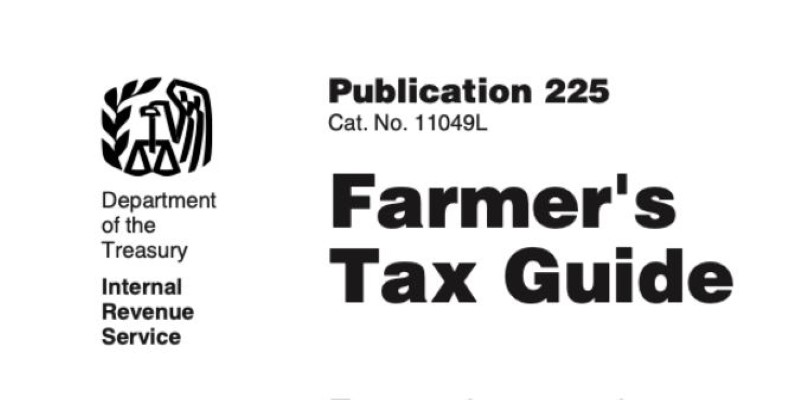Your Guide to Farm Income, Deductions, and Credits with IRS Publication 225
Dec 11, 2024 By Elva Flynn
For many farmers, tax season can feel as complex as harvest season. Understanding specific tax obligations for the agricultural sector is crucial, and thats where IRS Publication 225, also known as the Farmers Tax Guide, comes into play. This essential guide from the IRS demystifies the ins and outs of taxes for those in agriculture, covering everything from reporting income and deducting expenses to understanding credits and special deductions.

Whether you are an experienced farmer or just starting, managing tax liabilities is crucial in keeping your farm's books balanced. Here, we attempt to explain IRS Publication 225 in more palatable terms, making sense of its contents and how it would affect your farming operation.
What Is IRS Publication 225?
IRS Publication 225, or the Farmers Tax Guide, is a comprehensive tax resource provided by the IRS specifically for farmers and agricultural businesses. Unlike the general tax guides that cater to all types of taxpayers, this guide is tailored to the unique financial landscape of farming, where seasonal incomes, specialized expenses, and unique deductions create a distinctive tax situation. Farmers operate differently from other businesses, so it makes sense they have unique tax requirements that need specialized explanations.
The Farmers Tax Guide is updated annually, addressing changes in tax law that affect agricultural businesses. For example, new deductions, credits, and other incentives can be included in each years publication. The guide is extensive, covering various aspects such as types of income, how to handle losses, capital gains, and reporting obligations, making it a vital resource for farmers who want to stay compliant and maximize potential savings.
Key Areas Covered in IRS Publication 225
IRS Publication 225 organizes its information to ensure farmers know what to do at every step of the tax process, including what is included in farm income, deductions, and credits for which they may be eligible. Here's an overview of some of the central areas covered:
Understanding Farm Income

IRS Publication 225 is farm income. It isn't just selling produce; it includes government subsidies, conservation payments, crop insurance, and livestock revenue. For instance, it describes when the income comes in - in cash, by check, or through barter. In addition, the guide clarifies how to account for delayed crop insurance or disaster payments so farmers can maintain their records correctly while reporting earnings for tax purposes.
Deductible Expenses and Farm Deductions
Running a farm incurs significant costs, many of which can reduce taxable income. IRS Publication 225 details deductible expenses, from seeds and fuel to equipment and repairs. It highlights the importance of depreciation, letting farmers spread equipment costs over time, and explains the section 179 deduction, which allows immediate deductions on qualifying equipment. These insights help farmers manage tax burdens by correctly reporting deductions on major expenses.
Capital Gains and Losses
When farmers sell assets like land or equipment, they may face capital gains or losses. IRS Publication 225 explains tax implications, distinguishing between short- and long-term gains, which are taxed differently. The guide helps farmers report these transactions, offering strategies to offset gains with losses and minimize tax liabilities. By following these guidelines, farmers can handle asset sales accurately and potentially reduce their overall tax bill.
Farm Labor and Employment Taxes
Hiring farm labor, whether seasonal or year-round, involves various tax obligations. IRS Publication 225 covers payroll taxes, worker classification, and reporting requirements, emphasizing the need to withhold federal income, Social Security, Medicare, and unemployment taxes. Special rules apply when family members work on the farm, potentially easing tax burdens. This section ensures farmers meet legal requirements while managing payroll efficiently, safeguarding both compliance and cost management.
Credits and Special Tax Benefits
A few tax credits and special benefits are designed to aid farmers, making farming a bit more financially manageable. The Farmer's Tax Guide outlines these credits in an easy-to-understand way, allowing farmers to claim the benefits they're entitled to.

For example, farmers can take advantage of the Earned Income Credit if they meet certain income thresholds, and they may be eligible for conservation credits if they engage in environmentally friendly farming practices. There are also credits available for energy-efficient farming practices, such as using solar panels or wind turbines on the farm. These credits can reduce overall tax liability and may even lead to a refund, making them well worth investigating for any farmer looking to save on taxes.
The Importance of Recordkeeping
One of the most crucial aspects of farm taxes is maintaining good records. IRS Publication 225 emphasizes the importance of recordkeeping throughout the guide. Accurate records help farmers substantiate their income and deductions in the event of an audit. For farmers, keeping detailed records can mean the difference between qualifying for a deduction or missing out on valuable tax benefits.
The publication suggests keeping records of income, expenses, assets, and liabilities in an organized manner. Farmers need to keep track of receipts, sales records, and documentation of any loans or grants received. Publication 225 even offers tips on how to structure recordkeeping for tax purposes, suggesting that farmers keep digital and physical copies of essential documents.
Conclusion
IRS Publication 225, the Farmer's Tax Guide, is an invaluable tool for anyone in the agricultural sector. This guide takes the complexity of tax law. It breaks it down, making it easier for farmers to understand their obligations, leverage deductions, and take advantage of credits designed for the farming industry. By covering areas such as farm income, deductible expenses, capital gains, and labor taxes, it helps farmers navigate the often challenging tax landscape. While its possible to handle taxes independently with this guide, some farmers might find additional value in seeking professional help to ensure theyre fully benefiting from the tax laws available to them.








